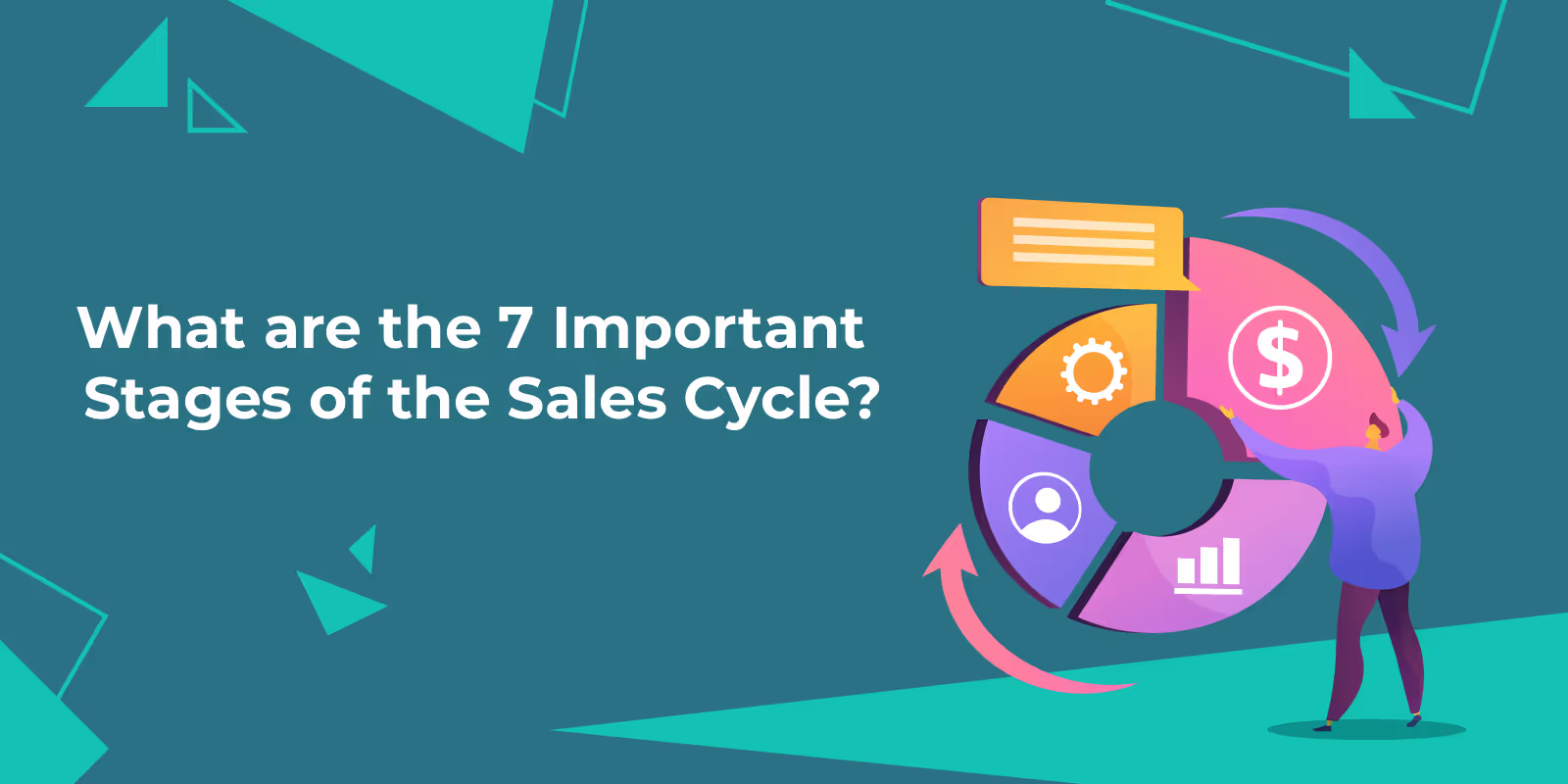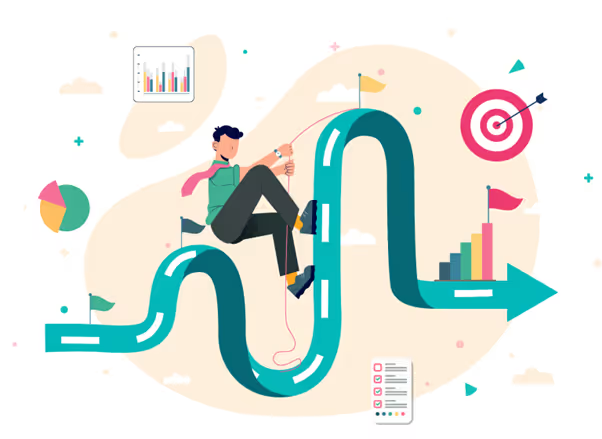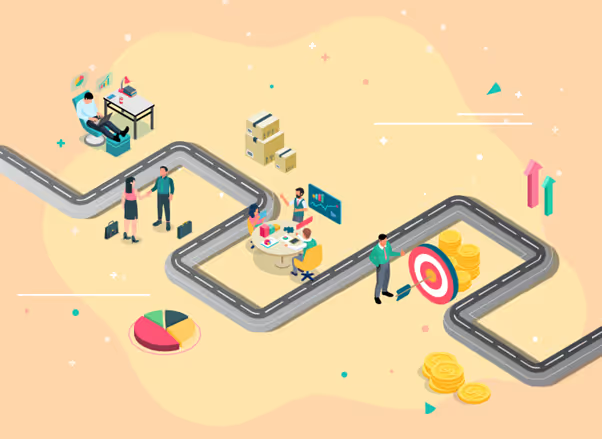
Blog
What are the 7 important stages of the sales cycle?
February 14, 2024


Key Insights
“If you can’t describe what you are doing as a process, you don’t know what you’re doing.”
-W. Edwards Deming
Building a path makes the journey smooth. This is exactly what designing a sales cycle does to your sales process as well.
Just as a path guides you to a destination, and gives a framework to your journey and milestones to the distance you have achieved; a sales cycle also helps you keep track of your sales journey.
If the sales cycle is so crucial to your sales, then let's delve into understanding what a sales cycle is, why it is important, how to go about creating a sales cycle, the 7 stages of sales, and how to optimize the cycle.
Scroll down for more.
What is a sales cycle?
Sales cycle refers to the strategic process salesforce follows from the initial contact with the potential client to finally closing the deal with them. It defines strategic stages that the prospects traverse before making the purchase.
The sales cycle stages include prospecting, qualification, needs analysis, product demonstration, proposal, negotiation, and closing. Depending on the industry, product, and sales approach, the sales management process guides each stage's progression, ensuring efficiency and effectiveness.
Salesforce can optimize its sales cycle process by incorporating automation tools like customer relationship management (CRM) to enhance its sales techniques and streamline the process.
Why is the sales cycle important?
Sales cycle plays an integral part in optimizing your entire sales process. Firstly, it provides a structure and framework that helps the salesforce while guiding their prospects in their decision-making process.
Using a sales process flowchart, teams can map out the customer's journey, identifying pain points and needs at each stage to craft personalized messaging and resources. This tailored approach increases the likelihood of a successful sale and nurtures a more meaningful customer relationship.
It is this timely sharing of the right resources and information that optimizes your sales strategy and overall sales performance. By creating a systematic approach to converting leads, the sales cycle ensures effective communication and relationship building that increases the chances of conversion.
Thus an effective sales cycle contributes to increased revenue, enhances customer satisfaction, and streamlines the sales process to ensure higher closing rates.
Enhance your sales cycle with 9 approaches to sales planning. Check Why Sales Approaches Are the Key to Your Business Success
How To Create A Sales Cycle?

Creating an effective sales cycle provides a systematic approach to guiding your prospects toward closing deals. Here is a step-by-step process for creating an effective sales cycle example:
Define Your Target Audience
The first step to any sales activity is in defining your target audience. Identifying your ideal customer profile, understanding their needs and requirements, and predicting the probable objections from their side, etc. Proactively identifying these points helps in building a flexible sales approach that can be tailored according to each customer's needs.
Lead Generation
An effective sales pipeline funnel not only focuses on lead generation but also includes a robust lead qualification process, evaluating factors such as budget, authority, and need, to determine whether a lead is ready to move to the next stage of the sales cycle.
Create a Sales Pitch
A crucial step of creating an efficient sales cycle lies in developing a compelling and tailored sales pitch that addresses the unique needs and challenges of your prospects. An effective sales pitch not only highlights the key features and benefits but emphasizes how the features benefit that particular prospect in enhancing their operations. This will have a huge impact on their decision-making process. Incorporating relevant sales KPIs into the pitch can further strengthen its effectiveness by demonstrating measurable outcomes and aligning with the prospect's objectives.
Product Demonstration
Product demonstration is when the prospect first has a view of your product. Hence it is important that the presentation not just showcase the key features of your product in a way that will have a decisive impact on the prospect. This involves enhancing the presentation through visual aids and emphasizing the product's effectiveness through testimonials and case studies. Incorporating these resources will strengthen your messaging.

Handle Objections
Objections and rejections are bound to arise in your sales conversation at any stage of the sales cycle. Hence, the sales force must anticipate these potential objections and prepare proactively to handle these concerns judiciously. Developing satisfying answers to their probable concerns will help build confidence in your offering.
Proposal and Negotiation
Salesforce must prepare a proposal that provides a clear and detailed outline of the terms, pricing, and other relevant details. When salesforce submits the proposal they must also be prepared to negotiate the terms so that both parties reach a point of mutually beneficial agreement. It is this discussion that will decide the closing of the deal.
Closing and Follow-up
Sales opportunity stages such as prospecting, qualifying, pitching, and closing are crucial, but nurturing the client relationship after the sale, addressing any issues, and exploring upselling opportunities are what transform a successful sales cycle into a lasting partnership.
To ensure consistent performance of your sales cycle, the salesforce must regularly review and refine your sales cycle by taking feedback on product performance and effectiveness.
The 7 Sales Cycle Stages

Sales cycle process involves seven stages that effectively take a potential client from being a prospect to a loyal customer. Let's explore these seven sales cycle stages for a better understanding:
Prospecting
In a B2B sales pipeline, prospecting involves researching and identifying businesses that could benefit from the product or service, utilizing various channels like cold calling, email campaigns, LinkedIn networking, and more to generate leads for further qualification.
Qualification
While prospecting gathers information about your potential buyers, effective sales cycle efforts must determine if they qualify as potential customers. This involves assessing if they need your product or not if they have the budget to buy your product, and if the person in contact has the authority to make the decision. This ensures that all sales efforts will eventually lead to a successful closing of the deal.
Needs Analysis
Sales professionals must work towards understanding the specific needs, requirements, challenges, and objectives of their qualified leads, utilizing tools like a sales growth calculator to inform their approach. This involves gathering information to identify their gap and thereby tailor the sales approach to meet their needs and bridge the gap effectively.
Product Demonstration
The product demonstration showcases the product to the prospective customer by highlighting the features, benefits, and value addition to the client's operations. This helps the prospect to understand how the product looks, evaluate its user-friendliness, and determine its effectiveness in enhancing its operations.
Proposal
At this stage of the sales cycle, a proposal is presented to the prospect which outlines the terms, pricing, and other relevant details. It serves as a formal document that helps the prospect understand the specifics of the proposed solution and make a positive decision based on it.
Negotiation
After presenting the proposal, the client will negotiate. This involves discussing the terms and pricing, raising concerns and objections, and discussing to find a common and mutually agreeable ground. A successful negotiation makes the final touch for closing the deal.
Closing
The final stage of a successful sales cycle is the closing of the deal. This involves making a commitment to purchase by signing the contract, completing the documentation and transaction as well as working on the onboarding process.
Though these are the 7 stages of a successful sales cycle, following up must be added as an eighth stage that enhances your entire sales process by ensuring customer satisfaction in the further phases.
How To Optimize Your Sales Cycle?
Salesforce must regularly review each stage of your sales cycle to ensure its effectiveness and efficiency. An inevitable part of this optimization process is incorporating automation tools that ease your routine and repetitive tasks. An automated sales cycle ensures enhanced performance with data-driven insights and fewer chances of error.
In a well-optimized sales workflow, CRM automation tools can segment and track leads, send customized pitches at relevant stages, and ensure efficient resource allocation, ultimately leading to higher engagement and an increased likelihood of closing deals.
In addition, the salesforce must take feedback on the effectiveness of your sales cycle to understand its strengths and areas of improvement. This helps in taking timely changes that help in ensuring the sales cycle effectiveness consistently.
Sales managers must also prioritize providing regular training and upskilling opportunities to their team, fostering a culture of sales team collaboration. This will have a positive impact on building a strong sales team as well as reflect in the customer relationship as well.
Thus to maintain an effective sales cycle, the sales team must be open and flexible to changing trends of the market.
To read more about these sales-related topics, visit https://www.kennect.io/. For more information Book A Demo NOW!
ReKennect : Stay ahead of the curve!
Subscribe to our bi-weekly newsletter packed with latest trends and insights on incentives.
Thank you! Your submission has been received!
Oops! Something went wrong while submitting the form.
Your data is in safe hands. Check out our Privacy policy for more info















